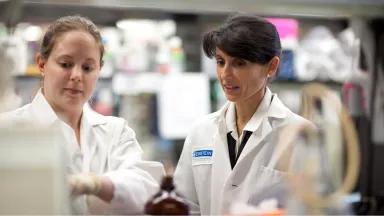
Airton Da Cunha Martins, Ph.D.
- Staff Scientist, Department of Molecular Pharmacology
Area of research
- Toxicology, Neurotoxicology, metals
Phone
Location
- Albert Einstein College of Medicine Jack and Pearl Resnick Campus 1300 Morris Park Avenue Forchheimer Building 209 Bronx, NY 10461
Research Profiles
Professional Interests
My overall research interests involve the development of a comprehensive understanding of cellular and molecular mechanisms underlying neurotoxicity and neurodegenerative disease, as well as the pathways involved in these processes after metal exposure, aiming to identify potential therapeutic targets.
Selected Publications
Martins, A. C., Virgolini, M. B., Ávila, D. S., Scharf, P., Li, J., Tinkov, A. A., Aschner, M. Mitochondria in the Spotlight: C. elegans as a Model Organism to Evaluate Xenobiotic-Induced Dysfunction. Cells, 2023, 12(17), 2124.
Ückert, A. K., Rütschlin, S., Gutbier, S., Wörz, N. C., Miah, M. R., Martins, A. C., Aschner, M.Leist, M. Identification of the bacterial metabolite aerugine as potential trigger of human dopaminergic neurodegeneration. Environment International, 2023; 108229.
Martins, A.C.; Ke, T.; Bowman, A.B.; Aschner, M. New insights on mechanisms underlying methylmercury- and manganese-induced neurotoxicity. Current Opinion in Toxicology, v. 25, p. 30-35, 2021.
Martins, A.C.; Krum, B. N.; Queirós, L; Tinkov, A.A.; Skalny, A.V.; Bowman, A. B.; Aschner, M. Manganese in the Diet: Bioaccessibility, Adequate Intake, and Neurotoxicological Effects. Journal of Agricultural and Food Chemistry, v. 68, p. 12893-12903, 2020.
Martins, A. C.; Gubert, P.; Villas Boas, G.R.; Meirelles, M.; Santamaría, A.; Lee, E.; Tinkov, A.A.; Bowman, A.B.; Aschner, M. Manganese-induced neurodegenerative diseases and possible therapeutic approaches. Expert Review of Neurotherapeutics, v. 20, p. 1109-1121, 2020
Espósito, B.P.; Martins, A. C.; De Carvalho, R. R.V.; Aschner, M. High throughput fluorimetric assessment of iron traffic and chelation in iron-overloaded Caenorhabditis elegans. Biometals, v. 33, p. 255-267, 2020.





